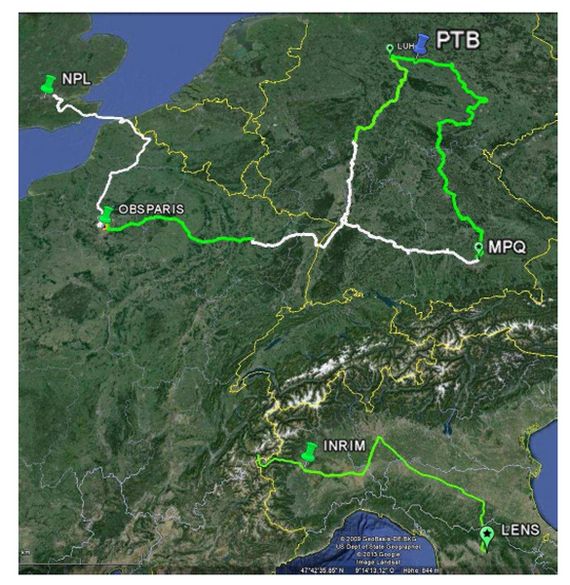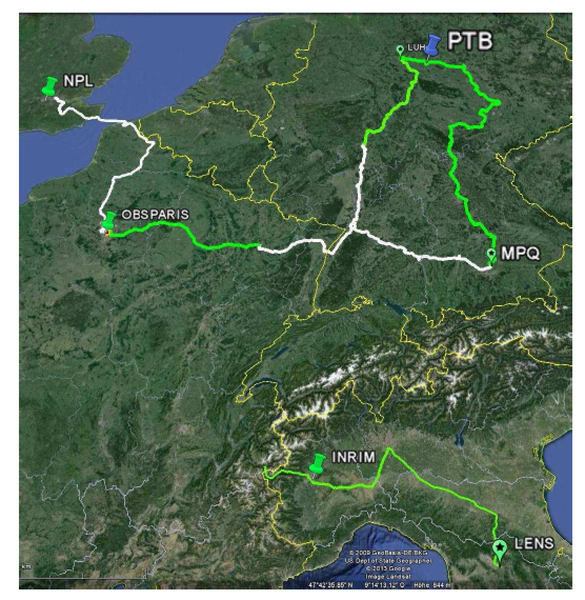


30 years ago, Vermeer and Bjerhammar suggested a new definition of the geoid, using the gravitational red-shift predicted by Einstein theory of General Relativity (Bjerhammar, 1985): “The relativistic geoid is the surface nearest to mean sea level on which precise clocks run with the same speed. The geoid is directly observable anywhere it is accessible.” Bjerhammar focused on clocks running continuously (mobile clocks), while early measurements of gravitational red-shift were reported for frequency comparisons using a frequency link between the clock locations (Pound and Snider, 1964; Vessot et al., 1980). Two problems, however, have delayed the scientific application of these ideas for geodesy:
- To achieve 1 m height resolution on earth, the clock rate (or frequency) needs to be realized with a relative fractional inaccuracy below 10^−16 at any location where the geoid is to be determined.
- The local clock rates (or frequencies) need to be transported and measured between the clock sites with significantly better stability compared to the performance of the clock. Ultimately aiming for 1 cm resolution, this requires clock rate intercomparison at or below the 10−18 level.
Now, laboratory clocks with frequency inaccuracy below 10−17 have been demonstrated, both for clocks based on single ions (Chou et al., 2010b) and clocks using neutral atoms (Bloom et al., 2013). In fact, a frequency instability near 10−18 (7 hours averaging) was reported (Hinkley et al., 2013). Chou et al. demonstrated the idea of relative height measurement with a resolution of 0.3 m, using two adjacent laboratory clocks (Chou et al., 2010b). The tremendous challenge of making clocks transportable is addressed in project A03, and further details are given there. This project A04 addresses the second point (ii): reliably transporting and measuring the clock rate, while aiming for fractional inaccuracy below 10−18, for distances of up to 1000 km, ideally reaching many locations simultaneously. We will achieve this by establishing phase-coherent optical fiber links between remote clocks, and measuring the clock frequencies, based on our previous experience (Grosche et al., 2008, 2009; Pape et al., 2010; Predehl et al., 2012; Matveev et al., 2013). Through close cooperation between projects A03 and A04, relativistic geodetic data spanning regional and later national distances with sub-meter height resolution will become available for the first time. Additional experiments via satellite microwave links, including, when available, the ground station of ACES (Seidel et al., 2007), complement this work. Specifically, within A04, the following four challenges to adapt and use optical links for geodesy will be addressed:
- refine signal amplification methods to provide continuous remote measurements (> 3 hours) over up to 1000 km distance
- assess link resolution and accuracy at the 10−18 level, including clock frequency measurements with frequency comb generators,
- connect many remote locations, thus realizing a geodesy clock network; and as a long-term vision
- transport and compare timing signals to enable time-scale (rather than just frequency) comparisons using mobile clocks.
We plan several field missions within this project to compare remote, stationary or portable clocks (project A03) via a fiber link to a local clock to determine the gravitational potential difference with a resolution at the cm-level. We will also support the characterization of improved GNSS (global navigation satellite system)-links, which are developed in project B03 for future gravity field measurements.
Principal Investigators
Physikalisch-Technische Bundesanstalt
Bundesallee 100
38116 Braunschweig
Physikalisch-Technische Bundesanstalt
Bundesallee 100
38116 Braunschweig
Physikalisch-Technische Bundesanstalt
Bundesallee 100
38116 Braunschweig
Physikalisch-Technische Bundesanstalt
Bundesallee 100
38116 Braunschweig


